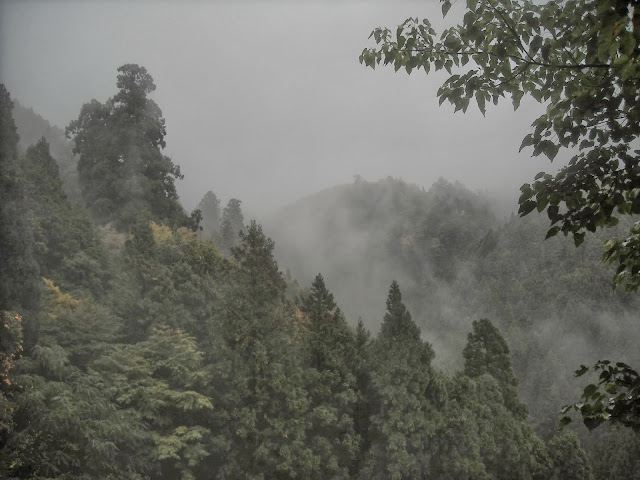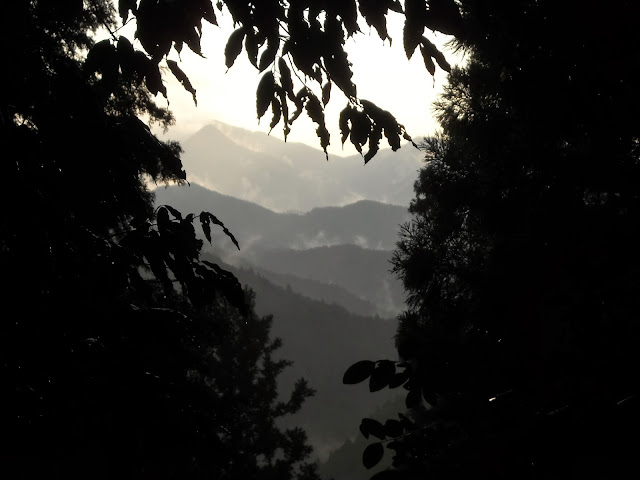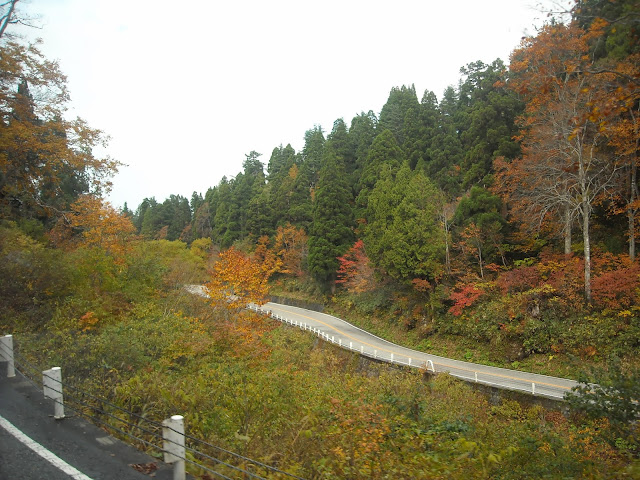Locations: Choishimichi Pilgrimage Trail, Koyasan Town, Okunoin Cemetery
After I spent a full week recovering (read: working long hours in lab) from my big trip to central Japan, I embarked once again on a journey into the mountains, although this time much closer to home.
Nestled in the coastal mountains of the Wakayama prefecture, about an hour's train ride south of Osaka, lies the Buddhist sanctuary known as Koyasan ("Mount Koya"). It's said to be the birthplace of Buddhism in Japan, and undoubtedly has most of the oldest and largest Buddhist temples in Japan. Although it's a more modern town now, complete with some residential areas and paved road access from the outside world, it's still very much isolated in a thickly forested mountain basin near the top of the mountains, at 800m (~2500 feet). More importantly, the majority of the town is still composed primarily of old temples and shrines, so the spiritual atmosphere of the place has been well preserved.
To properly experience the spirituality of the place, I decided to do an overnight temple stay in the town. Most of the lodgings available are in the form of temples, which run a very ryokan-like system, with a few more guidelines on noise and curfews (and of course, strictly vegetarian cuisine). I chose one of the more authentic, older temples (at a price), which also offered its visitors a chance to participate in a Buddhist meditation ceremony in the morning.
To warm up for this experience, I chose to hike the Choishimichi pilgrimage trail, which is the traditional route monks would take to reach Koyasan, before trains and cable cars came along. It's a 25km hike from the bottom of Wakayama valley and takes about 6-7 hours on average. I left early enough in the morning to accommodate for this, although in the end I definitely underestimated the difficulty of the trail.
The beginning of the trail climbed steeply up from the valley floor, weaving in and out of persimmon orchards. I had actually purchased a bag of persimmons from a farmer's market before setting out, so I easily resisted the urge to grab a few more that were hanging right over the trail. After a grueling 600m ascent, the trail leveled out in a cedar forest, and continued to follow the ridgeline for several hours. Some spots along the trail seemed like they were logged some time in the past, but the majority of the trail was beautifully preserved. Through its many ups and downs, the trail frequently switched between dark evergreen groves and brilliantly colored deciduous patches.
Once I was sufficiently far from the urban valley, the forest became very quiet and truly started to gain the spiritual quality that these mountains are rumored to possess. Every few hundred feet along the trail, I would pass an ancient stone pillar marking the trail (some are originals from hundreds of years ago, while others were recently restored). To really clear my mind and feel more spiritual, I paused at every pillar and listened to the stillness of the forest, sometimes silently paying my respects to whatever spirits resided in these mountains. After a while, I realized that I got too relaxed while enjoying the scenery, and had to rush through the last 2 hours of the hike (also aided by a brief rainstorm), climbing another steep slope to the gates of Koyasan. The forest rapidly became more ancient and overgrown as I neared the mountain basin, and by the time I emerged at the main entrance to the village, I felt like I had just passed through a rainforest. It was just past sunset, and my check-in time, when I finally arrived exhausted at my temple.
After an unexpectedly filling vegetarian diner, I slept very soundly, with the help of the excellent space heater in my room. Outside, the temperature dropped to freezing overnight! It wasn't easy going from building to building in the morning, but fortunately both their old dining hall and ceremonial buildings were equally well heated on the inside. For the ceremony, all of the participating guests (including me) were guided to a dimly lit entrance hall with several rows of wooden benches. At the other end of the hall, there were several gaps in the wall which allowed us to see inside the main chamber, where numerous monks sat with large books and other items I couldn't quite identify. At the center between the two rooms was a station for burning incense, which had already sufficiently aromatized the room by the time we entered and were seated.
The ceremony began with a lone voice melodically chanting, accompanied by the occasional ringing of a large bell. As several minutes went by, more voices would join in, often seamlessly covering each other when one needed to pause for breath. At one point, we all took turns kneeling in the center of the room, making a prayer, and adding several pinches of incense to the pot. The scent of incense grew dizzyingly strong as the monks' voices continued to reverberate through the hall and melt together into one smooth stream of sound. I wasn't sure how much time went by like this; I kept my eyes closed and my mind clear as possible, and just let the feeling of the ceremony permeate every part of my body. Near the end, a monk walked over and motioned us to follow the handout we were given when we entered the building. It was the Heart Sutra, and we did our best to mumble along as the monks recited it in unison. Finally, after the chanting slowly receded back to silence and the bells stopped echoing, we were all quietly guided back into the brisk morning air.
Overall, I had an incredibly enlightening stay at the temple. The accommodations were very much like a ryokan, except a bit more spacious, and guests ate their meals at the same time in the traditional dining hall (supposedly several hundred years old; the oldest of its kind in Koyasan!). The vegetarian cuisine was, without exception, very delicious and surprisingly filling. Since I didn't have to fear fish appearing on my plate, the meals were very easy to enjoy. The atmosphere was understandably more reserved and formal than a traditional ryokan, but the monks were still very friendly and even went out of their way to provide English explanations of the morning ceremony and the temple's history.
Since I intended to return to lab in the evening, I spent only half of the day walking around Koyasan and enjoying the sights. I didn't wander into any other temples or museums, but it was all quite beautiful from the outside as well. I devoted a full two hours to walk through the enormous Okunoin cemetery early in the morning. Shrouded in an ancient cedar forest, Okunoin holds the mausoleum of Kobo Daishi, the founder of Shingon Buddhism, and over hundreds of years many monks and feudal lords alike have had their tombstones erected here to be closer to Kobo Daishi. As a result, today Okunoin stretches for several kilometers through the cedar forest from Koyasan. It was bright and sunny during my visit, but apparently it's often shrouded in dense fog, which amplifies the sense of isolation and sacredness.
Having completely worn out my legs over the course of two days, I took the first train out of Koyasan after lunch, and was home in Osaka by mid-afternoon. Overall, it was an absolutely fantastic trip, and I'm glad I did as much as I could to get the full spiritual experience. I did learn, however, that I'm not nearly as fit as the monks who regularly made the journey up the Choishimichi! Nonetheless, adventure survived, and successful!
After I spent a full week recovering (read: working long hours in lab) from my big trip to central Japan, I embarked once again on a journey into the mountains, although this time much closer to home.
Nestled in the coastal mountains of the Wakayama prefecture, about an hour's train ride south of Osaka, lies the Buddhist sanctuary known as Koyasan ("Mount Koya"). It's said to be the birthplace of Buddhism in Japan, and undoubtedly has most of the oldest and largest Buddhist temples in Japan. Although it's a more modern town now, complete with some residential areas and paved road access from the outside world, it's still very much isolated in a thickly forested mountain basin near the top of the mountains, at 800m (~2500 feet). More importantly, the majority of the town is still composed primarily of old temples and shrines, so the spiritual atmosphere of the place has been well preserved.
To properly experience the spirituality of the place, I decided to do an overnight temple stay in the town. Most of the lodgings available are in the form of temples, which run a very ryokan-like system, with a few more guidelines on noise and curfews (and of course, strictly vegetarian cuisine). I chose one of the more authentic, older temples (at a price), which also offered its visitors a chance to participate in a Buddhist meditation ceremony in the morning.
To warm up for this experience, I chose to hike the Choishimichi pilgrimage trail, which is the traditional route monks would take to reach Koyasan, before trains and cable cars came along. It's a 25km hike from the bottom of Wakayama valley and takes about 6-7 hours on average. I left early enough in the morning to accommodate for this, although in the end I definitely underestimated the difficulty of the trail.
The beginning of the trail climbed steeply up from the valley floor, weaving in and out of persimmon orchards. I had actually purchased a bag of persimmons from a farmer's market before setting out, so I easily resisted the urge to grab a few more that were hanging right over the trail. After a grueling 600m ascent, the trail leveled out in a cedar forest, and continued to follow the ridgeline for several hours. Some spots along the trail seemed like they were logged some time in the past, but the majority of the trail was beautifully preserved. Through its many ups and downs, the trail frequently switched between dark evergreen groves and brilliantly colored deciduous patches.
Once I was sufficiently far from the urban valley, the forest became very quiet and truly started to gain the spiritual quality that these mountains are rumored to possess. Every few hundred feet along the trail, I would pass an ancient stone pillar marking the trail (some are originals from hundreds of years ago, while others were recently restored). To really clear my mind and feel more spiritual, I paused at every pillar and listened to the stillness of the forest, sometimes silently paying my respects to whatever spirits resided in these mountains. After a while, I realized that I got too relaxed while enjoying the scenery, and had to rush through the last 2 hours of the hike (also aided by a brief rainstorm), climbing another steep slope to the gates of Koyasan. The forest rapidly became more ancient and overgrown as I neared the mountain basin, and by the time I emerged at the main entrance to the village, I felt like I had just passed through a rainforest. It was just past sunset, and my check-in time, when I finally arrived exhausted at my temple.
Shrine and steps marking the beginning of the Choishimichi Pilgrimage Trail
Climbing up out of Wakayama valley
Into the woods...
Passing by hundreds of ancient stone pillars marking the trail
Early autumn foliage frames some picturesque views of the nearby mountain countryside!
Higher in the mountains, fog starts to cascade down the densely pine-covered slopes
At the end of the day, fog from the surrounding valleys dissipates into the fading sunlight
The enormous Daimon Gate, main entrance to Koyasan (with bystander for size comparison)
This high in the mountains, the trees are just as red as the torii gates!
Extraordinarily bright fall colors decorate the streets of this temple town!
Finally arrived safely at my temple, Fudo-in!
After an unexpectedly filling vegetarian diner, I slept very soundly, with the help of the excellent space heater in my room. Outside, the temperature dropped to freezing overnight! It wasn't easy going from building to building in the morning, but fortunately both their old dining hall and ceremonial buildings were equally well heated on the inside. For the ceremony, all of the participating guests (including me) were guided to a dimly lit entrance hall with several rows of wooden benches. At the other end of the hall, there were several gaps in the wall which allowed us to see inside the main chamber, where numerous monks sat with large books and other items I couldn't quite identify. At the center between the two rooms was a station for burning incense, which had already sufficiently aromatized the room by the time we entered and were seated.
The ceremony began with a lone voice melodically chanting, accompanied by the occasional ringing of a large bell. As several minutes went by, more voices would join in, often seamlessly covering each other when one needed to pause for breath. At one point, we all took turns kneeling in the center of the room, making a prayer, and adding several pinches of incense to the pot. The scent of incense grew dizzyingly strong as the monks' voices continued to reverberate through the hall and melt together into one smooth stream of sound. I wasn't sure how much time went by like this; I kept my eyes closed and my mind clear as possible, and just let the feeling of the ceremony permeate every part of my body. Near the end, a monk walked over and motioned us to follow the handout we were given when we entered the building. It was the Heart Sutra, and we did our best to mumble along as the monks recited it in unison. Finally, after the chanting slowly receded back to silence and the bells stopped echoing, we were all quietly guided back into the brisk morning air.
Overall, I had an incredibly enlightening stay at the temple. The accommodations were very much like a ryokan, except a bit more spacious, and guests ate their meals at the same time in the traditional dining hall (supposedly several hundred years old; the oldest of its kind in Koyasan!). The vegetarian cuisine was, without exception, very delicious and surprisingly filling. Since I didn't have to fear fish appearing on my plate, the meals were very easy to enjoy. The atmosphere was understandably more reserved and formal than a traditional ryokan, but the monks were still very friendly and even went out of their way to provide English explanations of the morning ceremony and the temple's history.
Since I intended to return to lab in the evening, I spent only half of the day walking around Koyasan and enjoying the sights. I didn't wander into any other temples or museums, but it was all quite beautiful from the outside as well. I devoted a full two hours to walk through the enormous Okunoin cemetery early in the morning. Shrouded in an ancient cedar forest, Okunoin holds the mausoleum of Kobo Daishi, the founder of Shingon Buddhism, and over hundreds of years many monks and feudal lords alike have had their tombstones erected here to be closer to Kobo Daishi. As a result, today Okunoin stretches for several kilometers through the cedar forest from Koyasan. It was bright and sunny during my visit, but apparently it's often shrouded in dense fog, which amplifies the sense of isolation and sacredness.
Leaving the Fudo-in temple lodge in the early morning
Beautiful autumn foliage forms a canopy over a canal
Walking through Okunoin
Many of the monuments and tombstones seem be regularly taken care of by the locals
It almost feels like the entire forest is one big cemetery...
Next to the cedar forest are more temples surrounded by colorful foliage
Walking back along the streets of Koyasan
Pond and garden by one of the main temples
Having completely worn out my legs over the course of two days, I took the first train out of Koyasan after lunch, and was home in Osaka by mid-afternoon. Overall, it was an absolutely fantastic trip, and I'm glad I did as much as I could to get the full spiritual experience. I did learn, however, that I'm not nearly as fit as the monks who regularly made the journey up the Choishimichi! Nonetheless, adventure survived, and successful!


















































